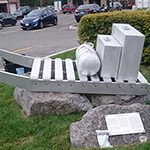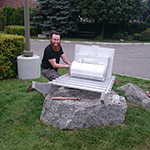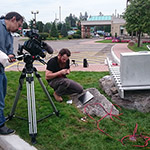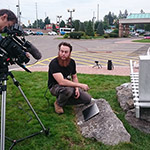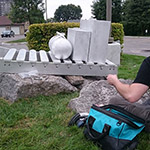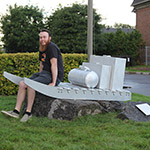From the North to Ottawa’s Southway Inn
Why does a hotel in Ottawa’s south end fly the flag of Nunavut? The answer to this question is a story of family, home, and community. It is also a story of Canada’s North and South. After opening in 1958 close to the city’s airport, the Southway Inn became a cherished place for people travelling to and from the Arctic, especially the Baffin Island region. More than just a place to stay, the Southway served as a wayfinder for new arrivals, Inuit men, women, and children who travelled to Ottawa for work, school, and healthcare. Today, Ottawa has the largest urban Inuit population south of the Arctic, including many whose first relationship to the city began with a stay at the Southway, now the Waterford Retirement Community, where commemorative artwork has been installed.

This story came from John Walsh, a professor at Carleton University, who was intrigued by the Nunavut flag he saw flying over the entrance of the Southway Inn. Further research led John -- project coordinator for this episode -- to discover how Inuit travelers from the North had stayed at the Southway while in Ottawa, mostly for medical services. Inspired by interviews with elders from the Ottawa Inuit Children's Centre, Inuk sculptor Couzyn van Heuvelen made travel central to his work -- installed in September 2017 -- which depicts a Qamutiik, a dogsled with a traditional Inuit design. Couzyn transformed it into a modern object made from aluminum, reflecting his interest in combining the traditional and the modern. These themes are also central to the documentary film: Qamutiik: From the North to Ottawa's Southway Inn by Inuk filmmaker, Mosha Folger.
Credits
Artist
Couzyn van Heuvelen
Couzyn van Heuvelen is a Canadian inuk sculptor. Born in Iqaluit, Nunavut, but living in Southern Ontario for most of his life, his work explores Inuit culture and identity, new and old technologies, and personal narratives. While rooted in the history and traditions of Inuit art, his work strays from established Inuit art making methods and explores a range of fabrication processes. Couzyn holds a BFA from York University and an MFA from NSCAD University. Couzyn.ca
Filmmaker
Mosha Folger
Mosha Folger is an Inuk originally from Iqaluit, Nunavut. His short films Never Saw It (2008) and They Called Her Sam (2016), and animated work The Big Lemming (2014) and Project of Heart (2013) have screened in Canada, the US, and Europe. His next project, Iglu:Angirraq (House:Home) (2018), a 60-minute documentary exploring Inuit housing and homelessness, is in production. Mosha is also a writer, performer, and hip hop artist, winning Best Music Video at ImagineNATIVE for his stop-motion video for Counterfeit Nobles – Sides (2012). He lives in Ottawa with his wife, daughter, and a terrier named Finch. Qaggiavuut.ca/mosha-folger
Project coordinator
John Walsh
John C. Walsh is a Canadian social historian and Co-Director of the Carleton Centre for Public History at Carleton University. His research and teaching interests include the study of collective memory and storytelling, some of which appears in his co-edited (with James Opp) collection, Placing Memory and Remembering Place in Canada (UBC Press, 2010). He has also contributed to the history of Ottawa, publishing essays on Ottawa’s Great Fire of 1900, the historical formation of a diverse German-Canadian community in the city, and most recently on how the city, as the national capital, historically emerged as a site of assemblage for heritage and public history. As an active supervisor of graduate students in Carleton’s M.A. in Public History program, he has also been actively involved in the making of historical documentary film, mobile computing apps, podcasts, educational websites, and digital museum exhibitions, working in partnerships with both national and local heritage organizations based in Ottawa.
Making the Art
Teaching Lost StoriesFrom the North to Ottawa’s Southway Inn
Teaching Lost Stories consists of a set of lesson plans and historical documents that encourage critical thinking about the history that is literally all around us. Teachers and students consider why some stories from the Canadian past have been commemorated through historical markers such as monuments, while other stories have been ignored.
Material prepared by Stephanie Lett, with the support of John Walsh, Co-Director of the Carleton Centre for Public History at Carleton University
